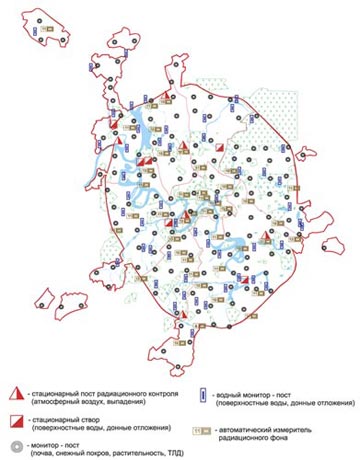Radiation and ecological monitoring of environmental objects
 Radiation situation in Moscow has been controlled systematically since 1987. Control of environmental objects radioactivity and radiation dosage on the territory of the city is carried out with reference to “Concept and Program of the Moscow Radio-ecological Monitoring”, approved by the Moscow government. Radio-ecological monitoring includes monitoring of environmental objects, systematization and generalization of the information, forming of the data bank, assessment of the total and local radiation situation as well as forecasting of potential situations. Radio-ecological monitoring system consists of mobile and stationary control facilities. Mobile facilities include motor and water complexes. Stationary facilities include regime monitoring system (134 posts), system of environment control (6 posts) and water basin (64 posts). Also there is a system of automated devices for radiation background measuring – 50 posts located at highways, large enterprises and in areas of mass people migration in all districts of the city. These posts form a totally automated element of the regional monitoring. Its functions are the following: continuous radiation background measurement during automatic monitoring of target background levels as well as connection with the information center in a case of their exceeding. Reading of devices is carried out round-the-clock and this information is given to the population on display panels.
Radiation situation in Moscow has been controlled systematically since 1987. Control of environmental objects radioactivity and radiation dosage on the territory of the city is carried out with reference to “Concept and Program of the Moscow Radio-ecological Monitoring”, approved by the Moscow government. Radio-ecological monitoring includes monitoring of environmental objects, systematization and generalization of the information, forming of the data bank, assessment of the total and local radiation situation as well as forecasting of potential situations. Radio-ecological monitoring system consists of mobile and stationary control facilities. Mobile facilities include motor and water complexes. Stationary facilities include regime monitoring system (134 posts), system of environment control (6 posts) and water basin (64 posts). Also there is a system of automated devices for radiation background measuring – 50 posts located at highways, large enterprises and in areas of mass people migration in all districts of the city. These posts form a totally automated element of the regional monitoring. Its functions are the following: continuous radiation background measurement during automatic monitoring of target background levels as well as connection with the information center in a case of their exceeding. Reading of devices is carried out round-the-clock and this information is given to the population on display panels.
Every year during the monitoring procedure more than 3 000 environmental samples are taken and analyzed, about 2 500 km of motor-gamma surveys are performed.
Decay products of radon coming from the air indoors make the main contribution to the city population irradiation with natural radionuclides. Thus, regular control of child preschool and school institutions, as well as living and public buildings was organized in Moscow.
Inspection of radiation dangerous objects has been performed in the capital since 1997 according to approved “Program of joint complex control of the Moscow radiation dangerous objects”. Results of these works help to assess general and local radiation situation in the monitored regions as well as its possible changes. Also the situation forecasting is carried out.
The monitoring results are used for making the Moscow annual radiation- hygienic passport, which includes summarized description of the main sources of environmental contamination, the population irradiation structure and annual effective dosage.
In the whole, the Moscow radiation situation is considered to be satisfactory as shown in the radiation-hygienic passport. However, great number of radiation dangerous objects in the megapolis doesn’t reduce probability of radiation accidents.
The Moscow FSUE Radon’s complex system responsible for environment radioactivity monitoring, revelation of sites with extended radioactive pollution, RW decontamination and disposal is one of the people radiation safety guarantees and rather important factor of stable social development.
















